

Parrandas Cancionero Navideño Puertorriqueño-letra y musica. El Boricua, a bilingual , cultural publication for Puerto Ricans.
Categoría:Parques nacionales de Bahamas. Categoría:Parques nacionales de Puerto Rico. Greater Antilles. Antillas Mayores. Las Antillas Mayores o Grandes Antillas son un grupo de islas en el mar Caribe localizadas al este de Yucatán (México) y sureste de la Florida (Estados Unidos) y al oeste de las Antillas Menores o Pequeñas Antillas.
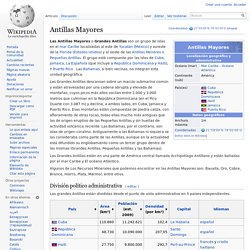
El grupo está compuesto por las islas de Cuba, Jamaica, La Española (que incluye a República Dominicana y Haití), Y Puerto Rico . Las Bahamas, si bien vecinas, no integran esta unidad geográfica. Las Grandes Antillas descansan sobre un macizo submarino común y están atravesadas por una cadena abrupta y elevada de montañas, cuyos picos más altos oscilan entre 2.000 y 3.000 metros que culminan en la República Dominicana (en el Pico Duarte con 3.087 m) y declina, a ambos lados, en Cuba, Jamaica y Puerto Rico. Esas montañas están compuestas de piedra caliza, con afloramiento de otras rocas, todas ellas mucho más antiguas que las de origen eruptivo de las Pequeñas Antillas y sin huellas de actividad volcánica reciente. Portail:Haïti. Portail:République dominicaine.
Puerto Rico. Coordinates: Puerto Rico (English /ˌpɔːrtə ˈriːkoʊ/ or /ˌpwɛərtə ˈriːkoʊ/;[a] Spanish: [ˈpweɾto ˈriko], locally also [ˈpwelto ˈχiko; ˈʀ̥iko]),[13] officially the Commonwealth of Puerto Rico (Spanish: Estado Libre Asociado de Puerto Rico, lit.
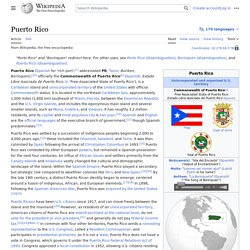
"Associated Free State of Puerto Rico"),[b] is an unincorporated United States territory located in the northeastern Caribbean Sea. It is an archipelago that includes the main island of Puerto Rico and a number of smaller islands such as Mona, Culebra, and Vieques. The capital and most populous municipality is San Juan. The territory does not observe daylight saving time, and its official languages are Spanish, which is predominant, and English.[14] The island's population is approximately 3.5 million. Puerto Ricans are natural-born citizens of the United States.[15] Puerto Rico does not have a vote in the United States Congress, which governs the territory with full jurisdiction under the Puerto Rico Federal Relations Act of 1950. Etymology History. Turks and Caicos Islands. The Turks and Caicos Islands (/ˈtɜrks/ and /ˈkeɪkəs/ / /ˈkeɪkoʊs/ / /ˈkeɪkɒs/), or TCI for short, are a British Overseas Territory consisting of the larger Caicos Islands and smaller Turks Islands, two groups of tropical islands in the Lucayan Archipelago, north of the larger Antilles island grouping.

They are known primarily for tourism and as an offshore financial centre. The resident population is about 31,500,[1] of whom 23,769 live on Providenciales in the Caicos Islands. Cayman Islands. Coordinates: The Cayman Islands (/ˈkeɪmən/ or /keɪˈmæn/) is a British Overseas Territory in the western Caribbean Sea.

The 264-square-kilometre (102-square-mile) territory comprises the three islands of Grand Cayman, Cayman Brac and Little Cayman located south of Cuba, northeast of Costa Rica, north of Panama and northwest of Jamaica. Its population is approximately 60,000, and its capital is George Town. Jamaica. Island country in the Caribbean Sea Jamaica () is an island country situated in the Caribbean Sea.
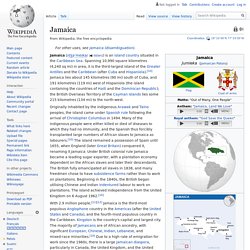
Spanning 10,990 square kilometres (4,240 sq mi) in area, it is the third-largest island of the Greater Antilles and the Caribbean (after Cuba and Hispaniola).[10] Jamaica lies about 145 kilometres (90 mi) south of Cuba, and 191 kilometres (119 mi) west of Hispaniola (the island containing the countries of Haiti and the Dominican Republic); the British Overseas Territory of the Cayman Islands lies some 215 kilometres (134 mi) to the north-west. Originally inhabited by the indigenous Arawak and Taíno peoples, the island came under Spanish rule following the arrival of Christopher Columbus in 1494.
With 2.9 million people,[11][12] Jamaica is the third-most populous Anglophone country in the Americas (after the United States and Canada), and the fourth-most populous country in the Caribbean. Kingston is the country's capital and largest city. Etymology History Prehistory Spanish rule (1509–1655) Dominican Republic. The Dominican Republic ( i/dəˌmɪnɨkən rɨˈpʌblɪk/; Spanish: República Dominicana [reˈpuβlika ðominiˈkana]) is a country on the island of Hispaniola, in the Greater Antilles archipelago in the Caribbean region.

The western three-eighths of the island is occupied by the nation of Haiti,[10][11] making Hispaniola one of two Caribbean islands, along with Saint Martin, that are shared by two countries. Both by area and population the Dominican Republic is the second-largest Caribbean nation (after Cuba), with 48,445 square kilometres (18,705 sq mi) and nearly 10 million people, one million of whom live in the capital city Santo Domingo.[2][12] Haiti. Country in the Caribbean Coordinates: 19°00′N 72°25′W / 19.000°N 72.417°W / 19.000; -72.417.
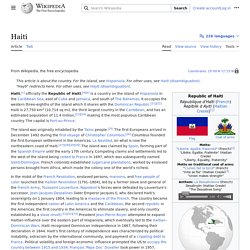
Hispaniola. It is the site of the first European settlement in the Americas founded by Christopher Columbus on his voyages in 1492 and 1493.[4][5] History[edit]
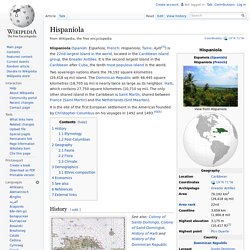
The Bahamas.